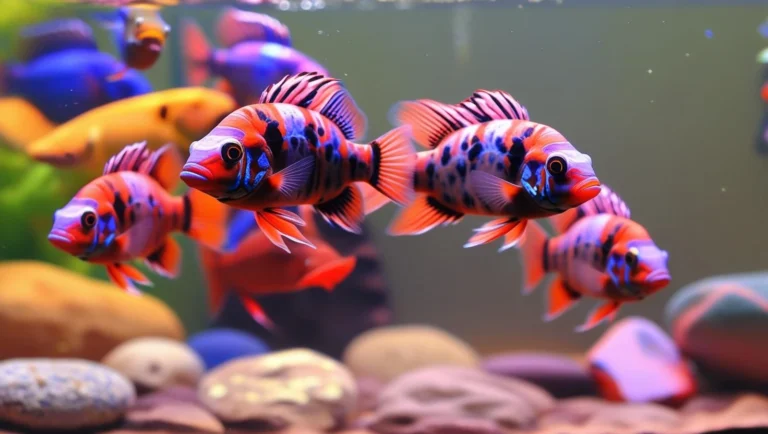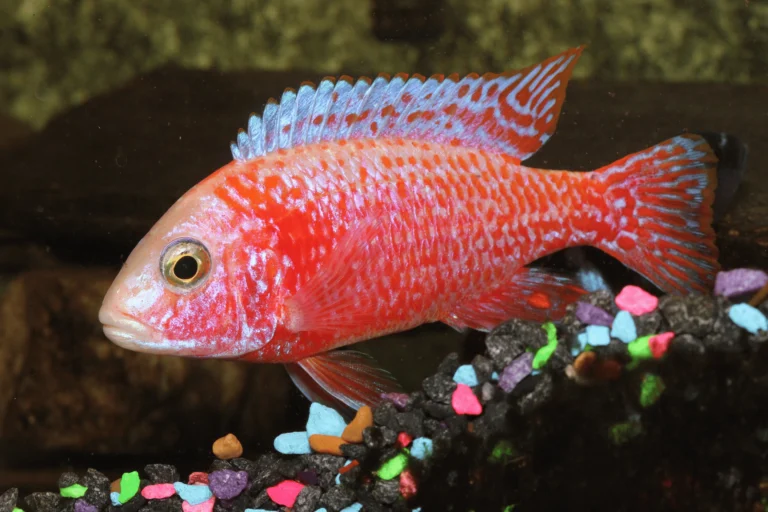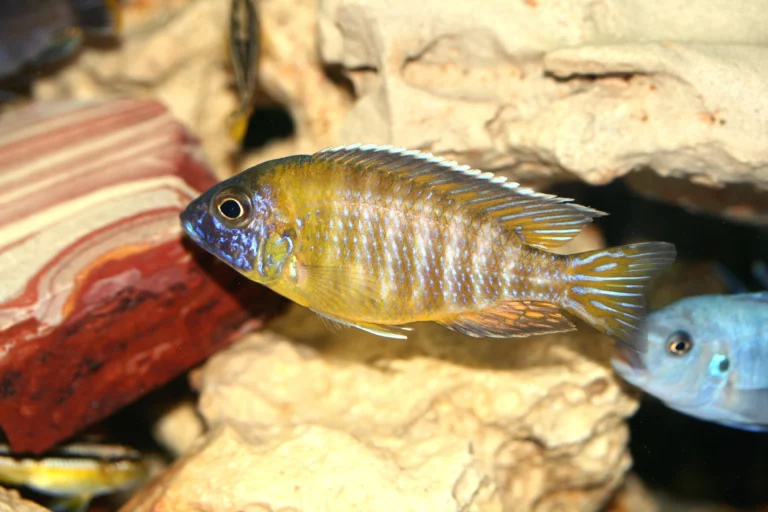Your trusted guide to cichlid care, tank setups, and quality products.

How to Keep Peacock Cichlid Fry Safe in a Community Tank: 7 Proven Methods
Protect your precious peacock cichlid fry in a community tank! Our expert guide reveals essential tips and strategies to ensure their safety and survival, even in a mixed environment.
Image credit Canva
Peacock cichlids are a favorite among aquarists, admired for their stunning colors and fascinating behaviors. However, raising peacock cichlid fry in a community tank can be challenging. These delicate fish are especially vulnerable to predation and competition for food. To ensure the survival and growth of your fry, you need a solid plan that covers everything from tank setup to feeding strategies.
In this guide, we’ll explore the most effective methods to keep peacock cichlid fry safe and thriving in a community tank. Whether you’re a seasoned aquarist or a beginner, these tips will help you protect your fry and watch them grow into beautiful adults.
At PeacockCichlid.com, we believe in transparency and honesty with our readers. Some of the links in this article are affiliate links, which means we may earn a small commission if you make a purchase through them—at no additional cost to you. These commissions help support our site, allowing us to continue providing expert advice, in-depth guides, and valuable content for Peacock Cichlid enthusiasts like you.
We only recommend products that we trust and believe will be beneficial for your aquarium. Thank you for your support!
Understanding Peacock Cichlid Fry and Breeding Behavior
To successfully protect peacock cichlid fry, it’s important to understand their breeding habits. Peacock cichlids are mouthbrooders, meaning the female carries fertilized eggs in her mouth to shield them from predators. Even after hatching, the fry remain in the mother’s mouth for protection until they are ready to swim freely.
Once the fry are released, their vulnerability increases significantly. In a community tank, they face threats from larger fish, aggressive tank mates, and even environmental stress. Fry are particularly sensitive to water quality fluctuations, which can compromise their health. This makes it crucial to have a plan in place to safeguard your peacock cichlid fry from the moment they become free-swimming.
1. Creating Safe Zones for Peacock Cichlid Fry
One of the most effective ways to protect peacock cichlid fry is by creating safe zones within the tank. These areas provide essential hiding spots that shield the fry from predators and reduce stress.
Safe Zone Ideas:
- Dense Aquatic Plants: Incorporate floating plants like hornwort or dense bottom plants like java moss. These plants create natural hiding spots for fry to retreat and avoid detection.
- Rock Caves and Crevices: Add rock structures or small caves with narrow openings. Ensure the spaces are small enough for the fry to enter but inaccessible to adult fish.
- Breeding Boxes: Breeding boxes offer a controlled space within the community tank. By placing your peacock cichlid fry inside these boxes, you protect them while maintaining stable water parameters.
Safe zones help peacock cichlid fry grow with a sense of security, allowing them to thrive without the constant threat of predation.
2. Choosing the Right Tank Size and Setup
Tank size plays a significant role in the safety of peacock cichlid fry. Peacock cichlids are territorial by nature, and overcrowding can lead to aggression that endangers fry.
Ideal Tank Setup:
- Tank Size: A minimum of 75 gallons is recommended for community tanks with peacock cichlids. Larger tanks reduce territorial disputes and provide more space for fry to hide.
- Aquascaping: Break up sightlines by using driftwood, caves, and plants to reduce aggression. Rearranging tank decor periodically can also help disrupt established territories.
- Water Parameters: Maintain optimal water conditions (75°F to 82°F, pH 7.8 to 8.6) to keep both adults and fry healthy.
By providing ample space and strategic aquascaping, you create a safer environment where peacock cichlid fry can develop without interference.
3. Isolating Peacock Cichlid Fry in Breeding Boxes or Nursery Tanks
For maximum safety, isolating your peacock cichlid fry can be a game-changer. This method minimizes risks and gives fry a safe environment to grow.
Isolation Methods:
- Breeding Boxes: Breeding boxes float inside the main tank, offering protection while allowing fry to benefit from the tank’s stable water conditions.
- Nursery Tanks: Setting up a separate nursery tank provides the ultimate safe space. While it requires extra effort, it ensures fry are completely protected from predators and competition.
Reintroduce fry to the community tank only when they are large enough to avoid being mistaken for food. A good benchmark is when the fry reach about 1 inch in size. Introduce them gradually, allowing both the fry and adult fish to adjust.
4. Feeding Peacock Cichlid Fry: Nutrition for Growth
Proper feeding is critical to the survival of peacock cichlid fry. These tiny fish have specific nutritional needs that must be met to ensure healthy growth.
Feeding Tips:
- Crushed Flake Food: Crush high-quality flake food into fine particles suitable for fry.
- Baby Brine Shrimp and Microworms: Live foods like baby brine shrimp and microworms are nutrient-dense and easy for fry to consume.
- Targeted Feeding: Use tools like turkey basters to deliver food directly to fry hiding spots, ensuring they get enough to eat without competing with adult fish.
- Frequency: Feed fry 3-4 times a day in small portions to encourage rapid growth and prevent water pollution.
Feeding peacock cichlid fry a varied and nutritious diet helps them grow quickly and strengthens their resilience.
5. Managing Aggressive Tank Mates
Aggressive tank mates pose a major risk to peacock cichlid fry. While some species coexist peacefully, others may prey on fry or harass them.
Compatible and Incompatible Species:
- Safe Tank Mates: Smaller plecos, tetras, and peaceful catfish make good companions.
- Avoid: Mbuna cichlids or other highly aggressive fish, which can endanger fry.
To manage aggression:
- Rearrange tank decor to disrupt territories.
- Temporarily remove aggressive fish until fry grow larger.
- Monitor behavior closely and take action if aggression escalates.
6. Maintaining Water Quality for Fry Survival
Clean water is crucial for the health of peacock cichlid fry. Poor water conditions can quickly harm fry due to their sensitivity.
Water Quality Tips:
- Filtration: Use sponge filters for gentle biological filtration that won’t suck up fry.
- Regular Water Changes: Perform weekly 10-20% water changes to keep ammonia, nitrites, and nitrates low.
- Monitor Parameters: Test the water regularly to maintain stable conditions ideal for fry development.
Pristine water ensures that peacock cichlid fry remain healthy and stress-free as they grow.
7. Best Practices for Long-Term Fry Growth
Ensuring the long-term survival of your peacock cichlid fry requires consistent care and monitoring. Here’s what you need to focus on:
- Gradual Reintroduction: Slowly reintroduce fry to the community tank once they are large enough to avoid predation.
- Consistent Feeding: Maintain a feeding schedule that supports steady growth.
- Disease Prevention: Keep an eye out for signs of illness, such as ich or fin rot, and address issues promptly.
- Observation: Regularly monitor the behavior and size of fry to adjust care as needed.
With patience and the right care, your peacock cichlid fry will grow into healthy, vibrant adults that enhance your aquarium.
Conclusion: Helping Your Peacock Cichlid Fry Thrive
Raising peacock cichlid fry in a community tank can be both challenging and rewarding. By creating safe zones, isolating fry when necessary, providing proper nutrition, and maintaining water quality, you can significantly increase their chances of survival.
With these proven methods, you’ll ensure your peacock cichlid fry thrive and grow into stunning adults. If you enjoyed this guide, share it with fellow aquarists and explore more expert tips at www.peacockcichlid.com, your go-to resource for all things peacock cichlids!
FAQ’s
How long do peacock cichlid fry stay in the mother’s mouth?
Peacock cichlid fry typically stay in the mother’s mouth for 2-3 weeks before being released as free-swimming fry.
What is the ideal tank size for raising peacock cichlid fry?
A minimum 75-gallon tank is recommended to provide enough space for fry to hide and grow safely.
What should I feed peacock cichlid fry?
Feed fry crushed flake food, baby brine shrimp, and microworms to ensure proper nutrition.
How can I keep fry safe in a community tank?
Create safe zones using dense plants, rock caves, and breeding boxes to protect fry from predators.
When should I move fry to a nursery tank?
Move fry to a nursery tank as soon as they are free-swimming for maximum safety.
How often should I feed peacock cichlid fry?
Feed fry 3-4 times a day in small amounts to encourage steady growth.
When can I reintroduce fry to the community tank?
Reintroduce fry once they are about 1 inch in size to prevent predation.
What water conditions are best for peacock cichlid fry?
Maintain temperatures of 75°F-82°F and a pH of 7.8-8.6 for optimal growth.
How do I prevent aggression toward fry?
Rearrange tank decor, isolate aggressive fish temporarily, and choose peaceful tank mates.
What are common diseases that affect peacock cichlid fry?
Fry are susceptible to diseases like ich and fin rot. Monitor water quality and treat symptoms promptly.



